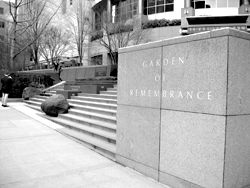The Garden of Remembrance on the Second Avenue side of Benaroya Hall is showing its age—and an excess of optimism.
Unveiled with the hall on July 4, 1998, when the biggest conflict facing the country was the Clinton-Lewinsky impeachment, it bears over 8,000 names of dead Washington state soldiers inscribed on black granite slabs labeled World War II, Korea, and Vietnam. The northernmost slab contains the weirdly coupled “Persian Gulf–Grenada” roster, which, back in ’98, consisted of 12 soldiers: 11 who were killed in Bush I’s Operation Desert Storm and one who died in Reagan’s 1983 attack on Caribbean Communism.
Unfortunately, the memorial is now facing the awkward, unexpected reality of Bush II and is literally unfit to handle the carnage. Names of 63 Washington state soldiers who’ve lost their lives in Operation Iraqi Freedom and Operation Enduring Freedom (Afghanistan) have already been squeezed onto the Persian Gulf–Grenada slab, which is mostly taken up by a letter from a dead WWII aviator. But there’s scant room left to accommodate a conflict that’s already outlasted that war.
“It’s getting a little tight,” says Mike Eagan, the P.R. manager for the Seattle Symphony Orchestra and the chair of the memorial’s advisory board.
“We certainly did not anticipate adding a war this soon, or a war at all,” says Dave Barber, a fellow board member (and, like Eagan, a Vietnam vet). The memorial, he says, “was not designed to expand.”
Created by the late Japanese-American landscape architect Robert Murase (whose family was shipped off to a Utah internment camp during WWII), the memorial was mostly funded by the late heiress Patricia Bullitt Collins, the former chairwoman of KING Broadcasting and an environmental benefactor. The dead aviator’s letter engraved on the memorial is, not coincidentally, that of her Seattle fiancé, Larry Norman, whose bomber was shot down over Germany in 1943. His body was never recovered, and thus his name was never recorded at the old (and now demolished) Public Safety Building’s veterans memorial, a wrong that Bullitt Collins intended to right with her $3.5 million Garden of Remembrance.
“It was never determined in a formal sense how frequently the memorial would be updated,” says Eagan. Names have occasionally been added over the years, with small ceremonies the last couple years on Memorial Day. But to give the newest dead their due, the memorial faces the prickly question of expanding. The last time a slab was changed, it cost about $10,000, says Barber. Redoing the gray granite capstones that designate each war would be more expensive and potentially disruptive, he says. “I think the Benaroya Hall people have been a little reluctant to go that route.”
Right now, one might argue, there’s not much to disrupt at the garden, which lies in one of those well-intentioned, forlorn public plazas used mainly by shivering smokers. It will get a little more pedestrian traffic once the nearby bus tunnel entrance reopens.
About 13 new honorees are waiting to be carved into the granite, and by this spring the list will surely be longer, as board members compile and verify Department of Defense casualty reports. (See here for our own updated war tallies.)
The board, which meets quarterly, has discussed the problem of expanding the war dead at the expense of their letters home. Barber says he would go back to the original design firm, now run by Robert Murase’s son, Scott, to make any changes.
“I’m not sure that there is a very good fix available,” Barber concedes. Then there’s the troublesome nomenclature: the Iraq War, Operation Iraqi Freedom, Iraq, or what? During talks thus far, says Barber, “Nobody wanted to put ‘War on Terror’ on the capstone.”








